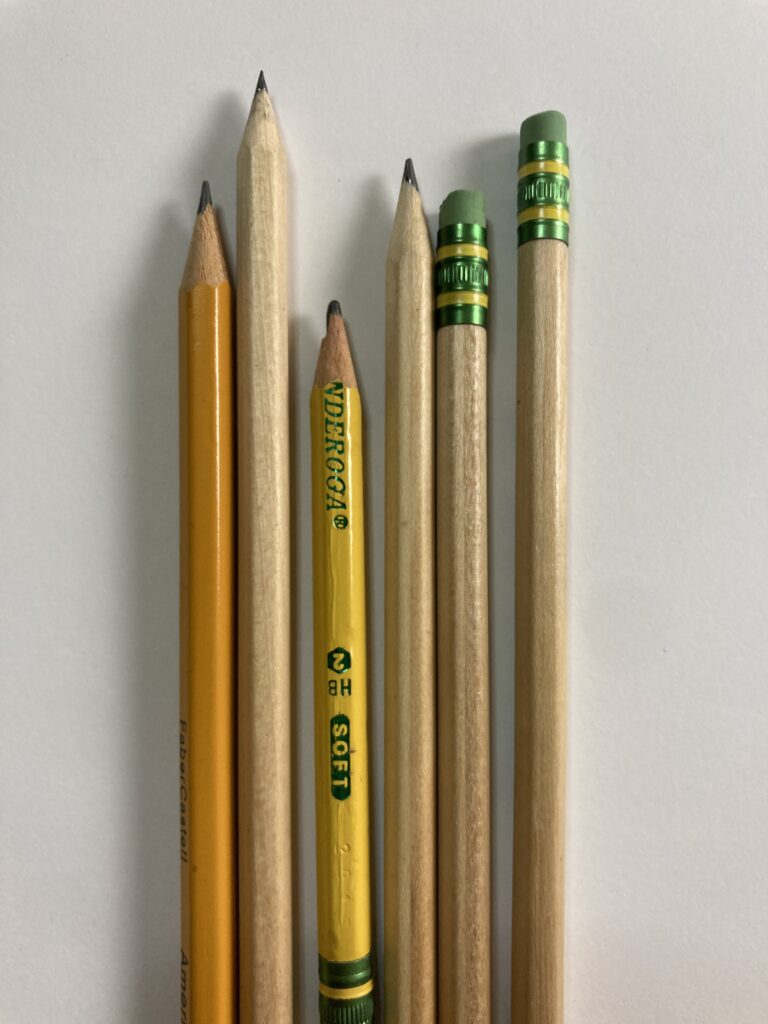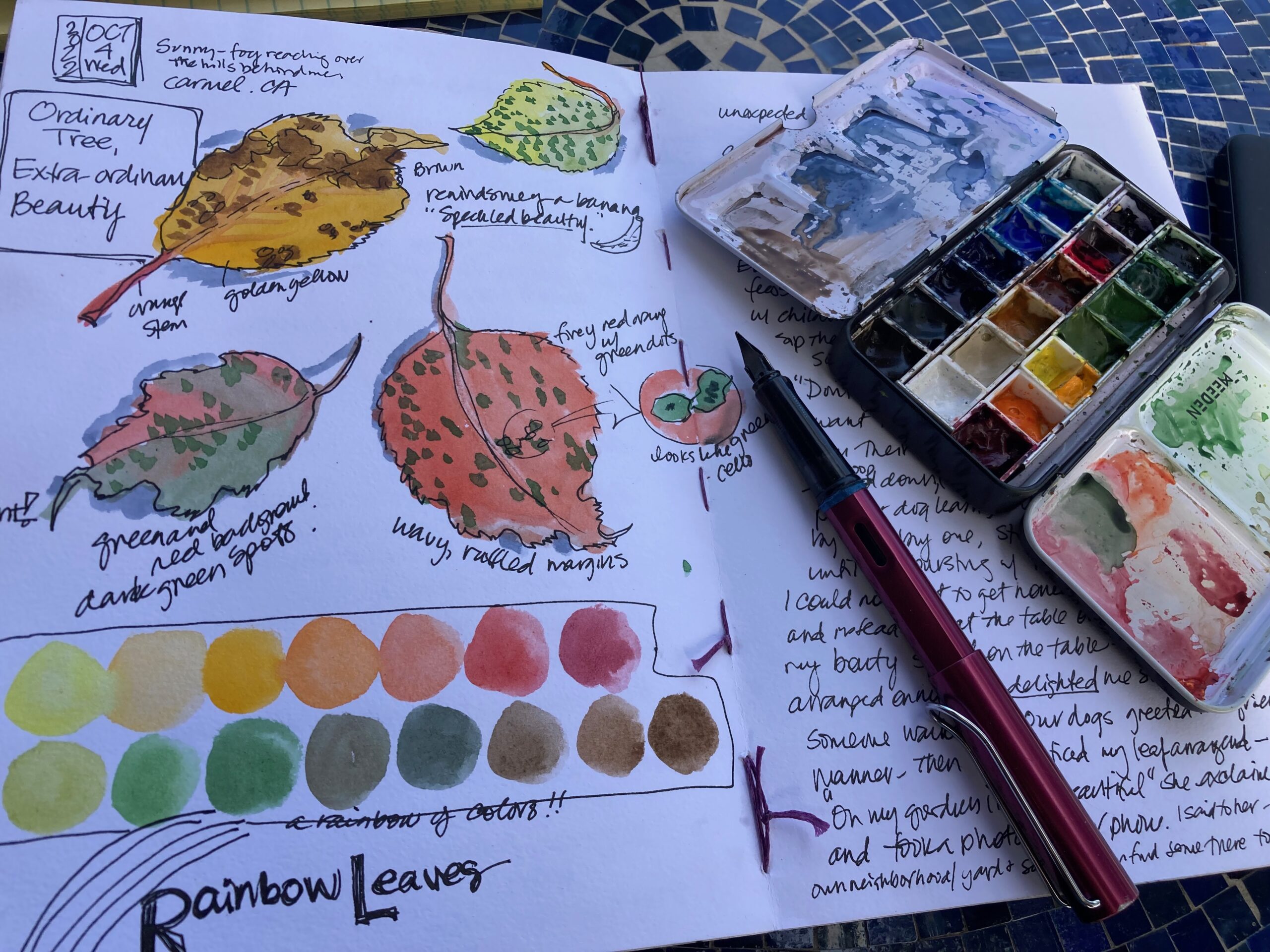
Tools for Nature journaling are simple. A journal and something to write with. Start with what you already have! As you start journaling, you’ll begin getting a feel for what you DO like –like maybe a larger notebook, or small kit or a fountain pen.
Do not let lack of the ‘right’ supplies prevent you from nature journaling.
The best tools are the ones you will use.
For example, if you don’t like how your pen writes or how the paper feels, try something different. The supplies and tools your teacher or accomplished nature journaler uses won’t make you a better nature journaler. Practice will make you a better journaler, and there are some tools that might help make it more fun.
Tools or supplies will not make you a better nature journaler. Diving in and practicing will make you a better nature journaler.
If you are totally new, please take a look and don’t feel you have to use all these tools. Start with what you have and try new ones when you feel the need to change.
After you begin noticing nature and recording your experience in the journal, you’ll start to get a sense of whether your journal size is too small or large, or the texture of the paper suits you or you want to try watercolor or colored pencils.
I’ve listed some materials below, along with why I like them. There are some Amazon affiliate links, but I don’t receive credit or commissions on other links.
I highly encourage you to visit your local art store to purchase your supplies. However if you do not have one near you, there are some Amazon affiliate-linked items below, which will send me a small amount of money per purchase.
What I currently use:
- Hard-bound hand-made sketchbook,
- Lamy fountain pen with
- waterproof ink,
- Daniel Smith watercolors in my personally hand made kit
If you are just starting out, look into these:
Canson mixed media spiral bound sketchbook
Pencil/pen
See below for descriptions
Sketchbook:
I like unlined mixed media paper for the way I journal.
My current sketchbook: hand bound custom journals
I now make my own journals because I haven’t found an off-the-shelf journal that fits the bill.
I use Canson mixed media paper, and make a hardback, 7inchx10inch book that lays flat. I go through the 120 pages in 2 months. This paper is a medium grade- so that I don’t get hung up with my inner critic makes it hard for me to fill pages if the journal is too expensive.
A fun thing is that I can now use my favorite fabrics or pretty paper that I’ve been storing for years! I can customize the colors, stitching, the size, add pockets, etc.



I offer in-person bookbinding workshops. Fill out this form if you are interested in learning how to make one of your own. You can also buy one of my self-paced online course here.
2nd choice: Canson XL Mixed Media sketchbook, 7×10 size , or a 2-pack here-(better price).
I’ve used this for several years. Its mixed media paper that is thicker (98#) than drawing paper, and takes watercolor well. It buckles a bit if you add a lot of water, but I personally don’t mind that. The spiral binding allows it to open and fold back so its easy to hold when I’m outside. Hard cover makes it easy to journal while standing. However, if you use only graphite pencil, the pages will rub together and eventually smear.
SIZE: recommend getting the largest size you will be comfortable taking outside with you. SO that you will have plenty of “breathing room” to journal. For me, 9×11 is too big and 5×7 is too small, my hand gets cramped when I’m trying to draw in small pages. I like the 7×10 size, its perfect for me.
Here are other sizes it come in:
- Canson XL Mixed Media sketchbook, 7×10 size
- 5.5 x8.5 Canson XL Mixed Media sketchbook,
- 9×12 Canson XL Mixed Media sketchbook
Another smaller hardbound sketchbook
I also like John Muir Laws’ sketchbook. It’s nicely bound, lays flat when open, smooth paper, and has some toned paper in the back. Has a blank canvas cover you can decorate and nature journal resource pages in the back. For me, it’s a bit too small and not enough pages.
- Laws Sketchbook for Nature Journaling, you can also get it here on John Muir Laws’ webstore
Pencils

I don’t use a pencil very often, but when I do, its a wooden #2 pencil. I do carry a mechanical pencil that I like to have in my bag for use on waterproof paper (I like these Rite-in-the-rain notebooks)
Zebra M-701 Stainless Steel Mechanical Pencil, 0.7mm Point Size, Standard HB Lead This one has metal barrel instead of plastic.
Waterproof Pens
My current Pen: LAMY AL-Star Fountain Pen
I use a fountain pen with waterproof ink. I like a thicker line so I use the medium nib. (With a Fine tip, I end up getting caught in putting too much detail).
Mine has a metal barrel, and refillable ink cartridge converter and I refill from a glass bottle of ink, so its got no waste!
- Metal barrel (less plastic!)
- Refillable ink converter cartridge (no waste! Refill ink from glass bottle)
- Waterproof ink in glass bottle (less plastic waste)
- Fun bright colors available: so that I won’t lose it in nature–
- Medium and find nib options
- Triangular grip section- doesn’t slip out of my hand or roll off a flat surface (I almost lost a pen this way)
- Cap stays on and post on the end firmly (although after daily use over a year it gets a bit loose)
- The cheaper plastic version is the Lamy Safari.
LAMY Al-Star Fountain Pen, Purple, Fine nib
LAMY Ocean Blue Fountain Pen with Medium Nib and Blue Ink (L28M)
Lamy Z28 Converter– This is the ink cartridge converter so you can refill the ink.
INK: Platinum Carbon waterproof ink– 60ml Bottle, Black
Lamy pens from Goulet Pens
Other waterproof pens:
For many years I used the Sakura Micron pens, in various tips. But over time, here’s why i stopped:
- No ink refills-Single use, disposable. : (
- if nib broke (this happens easily when I drop the pen with cap off) no replaceable nibs.
- every time I bought it, it was more plastic waste (body is plastic)
In my desire to reduce my use of plastic and disposable items, I found an alternative.
The Copic Multiliner SP is similar, but has a metal barrel, replaceable ink cartridges and replaceable nibs. It comes in various nib sizes, but these are the two I used most: 0.1 and 0.5
Merriartist.com has the best prices for these pens. They are a family-owned art supply store in Oregon. I do not get any commissions. Please support your local art store, or try Merriartist.com. These are pricier–but remember they are reusable and refillable.
Fine TIP
- Copic Multiliner SP, 0.1 tip: fine tip pen.
- Copic Multiliner, SP Refill cartridge A (for 0.1 tip)
MEDIUM TIP
- Copic Multiliner SP, 0.5 tip: medium tip
- Refillable cartridge B (for 0.5 tip)

Watercolor paints
Just get something to start with:
You can use an inexpensive set to start with. I started with a $5 watercolor mini kit from the craft store, and glued it into a metal tin (see photo below). And as I used up the colors I replaced them with higher grade paint from a tube (Daniel smith).
You can get a small travel kit, Sakura Koi Pocket set with 12 color great for nature journaling.
Melinda’s custom watercolor travel palettes- limited quantity available.
I’ve put together a small palette in a metal tin (instead of plastic) with 12 of my favorite nature journaling paints (Daniel Smith Extra Fine Watercolors). To purchase yours, go to this form.

Waterbrush
I use a waterbrush with my watercolors. It comes with a barrel that holds water, so just squeeze the barrel to wet the bristles, dip into paint and start painting. To clean the bristles between colors, squeeze to let water out and wipe the brush tip on a cloth to remove color until its clean. Its convenient to use when outdoors.
Pentel Aquash Water Brush (Fine Point Large)
- Large water reservoir, lasts a good amount of time for me
- Large brush holds lots of water for washes over big areas,
- AND fine point so I can get small details
Colored pencils
I have used Prismacolor Premier colored pencils for years and I still use them. They have a nice rich lead with vibrant colors. Here is a nice assortment:
Prismacolor 3597T Premier Colored Pencils, Soft Core, 24-Count
Prismacolor Premier Colored Pencils, Soft Core, 72 Pack with Pencil Sharpener

Just a reminder, the paper and paint do not make you a better nature journaler. Practice noticing nature, recording in your journal, and pencil- and brush-miles is what will make your skills improve! Don’t let lack of supplies or fear of not having the ‘right’ supplies prevent you from journaling! Use what you have and you can upgrade as you grow in confidence!
You CAN totally do this!!!
